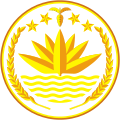| Upazila | |
|---|---|
 | |
| Category | Administrative divisions |
| Location | Bangladesh |
| Created |
|
| Number | 495 |
| Populations | 596,886–1,634,750 |
| Areas | 572–2,829 km2 |
| Government |
|
| Subdivisions |
|
| This article is part of a series on the |
| Politics of Bangladesh |
|---|
 |
|
|
|
|
An upazila (Bengali: উপজেলা, romanized: upajēlā, lit. 'sub-district' pronounced: ['upɘdʒeːlaː]), formerly called thana, is an administrative division in Bangladesh, functioning as a sub-unit of a district. It can be seen as an analogous to a county or a borough of Western countries. Rural upazilas are further administratively divided into union council areas (union parishads).
Bangladesh has 495 upazilas.[1][2][3] The upazilas are the second lowest tier of regional administration in Bangladesh. The administrative structure consists of divisions (8), districts (64), upazilas (495) and union parishads (UPs). This system of devolution was introduced by the former military ruler and president of Bangladesh, Lt-Gen Hossain Muhammad Ershad, in an attempt to strengthen local government.
Below UPs, villages (gram) and para exist, but these have no administrative power and elected members. The Local Government Ordinance of 1982 was amended a year later, redesignating and upgrading the existing thanas as upazilas.[4]
- ^ "Govt to form 3 new upazilas in three districts". The Daily Star. 27 July 2021. Archived from the original on 30 August 2021. Retrieved 20 October 2022.
- ^ "upazila List". Bangladesh National Portal. Archived from the original on 10 July 2019. Retrieved 10 August 2015.
- ^ "New upazila to be formed in Comilla". NTV. 9 January 2017. Archived from the original on 16 April 2021. Retrieved 20 June 2017.
- ^ Kamal Siddiqui (2012). "Local Government". In Sirajul Islam and Ahmed A. Jamal (ed.). Banglapedia: National Encyclopedia of Bangladesh (Second ed.). Asiatic Society of Bangladesh. Archived from the original on 6 November 2016. Retrieved 6 August 2015.


